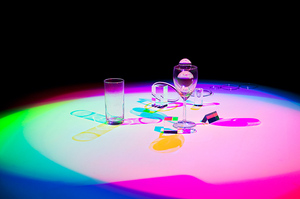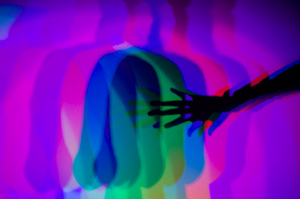Some Questions to Daito Manabe and Motoi Ishibashi
Daito Manabe (Artist / Programmer / DJ)
Motoi Ishibashi (Artist / Engineer)
Maison de la culture du Japon à Paris (The Japan Foundation), commonly abbreviated to MCJP, hosts a series of exhibitions Transphère to introduce new creativity, which corresponds to sensibility of people living today, from international perspectives. Under the supervision of the MCJP's artistic director Aomi Okabe, the series is to exhibit nationally and internationally active contemporary artists, architects, designers, and other artists and creators. As the first exhibition of the series, the MCJP held Fertile Landscape welcoming the media artists Daito Manabe and Motoi Ishibashi, who have a mastery of cutting-edge technology, between March 16 and May 7, 2016.
We reprint the interview of the two artists, which was originally appeared in the exhibition catalogue, together with pictures taken at the exhibition and the artists' past works.
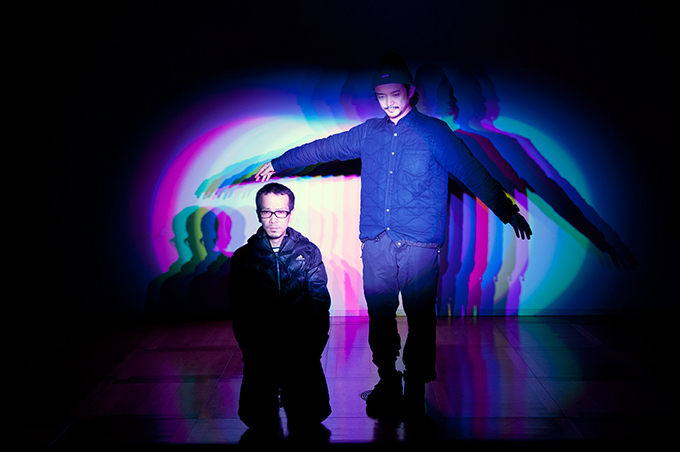
Left and right: Daito Manabe + Motoi Ishibashi rate-shadow, 2016
Photos: Graziella Antonini
Both of you are a part of Rhizomatiks, as programmers and engineers, and have also co-founded Rhizomatiks Research, as a researcher and developer. Throughout these diverse activities, how do you differentiate your respective practices as artists, and categorize the various titles you have?
Ishibashi: There are two big ways to categorize these titles. The big difference being, is it a project we're leading, or is it a project we had an offer or request for, and are helping with? For example, with the dance company ELEVENPLAY, with whom we have completed several projects, there have been times when we with our vision lead the project, and then there were other times when we were offering technical assistance for their performance. There are usually two types of performances too. MOSAIC (2012) was led by ELEVENPLAY, and border (2015) was led by us. It is usually a 50-50 ratio.
With border, you controlled personal mobility ("WHILL," an electric wheelchair), where the audience sits, with a remote, and creates a new approach to physicality. Where did all this start from?
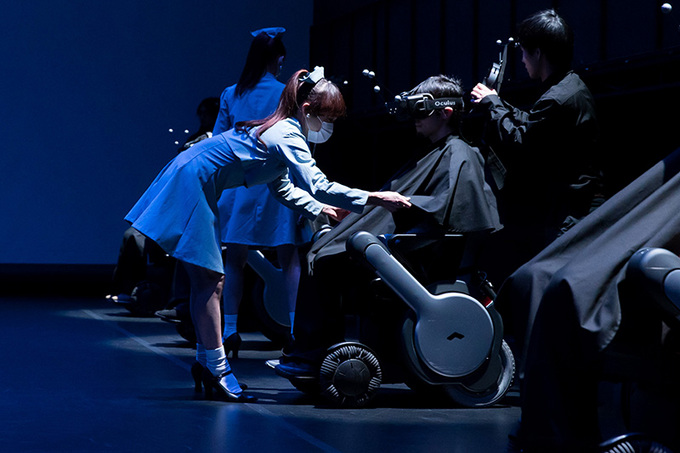
Rhizomatiks Research + ELEVENPLAY border, 2015
Photo: Muryo Homma (Rhizomatiks Research)
Ishibashi: It began with curiosity for creating an experience for wearing VR or head mounts. But the performance wouldn't be possible if the audience moved around freely, so we were thinking about how to make this experience possible. It just so happened that we met someone from WHILL, and we thought, let's try this, and the collaboration happened. Also, by using the "Omniwheel," which moves in any direction, we were able to change the positioning freely, so the stage set could also be controlled remotely, and move without a person there.
What is your motivation behind your artistic practice?
Manabe: Let's talk about what lies at the root of it, rather than the motivation. For example, if I had wanted to express myself with words, I probably would have become a singer or a writer. The reason I chose music and numbers as the medium for expression was precisely because I didn't want to use words. That is because I was attracted to the universality of things that aren't words. Language can change after 100 years, or 1000 years, but numbers aren't man-made. They exist in nature and were discovered by humans, and they cannot be altered. I get the impression that mathematicians are also attracted to this characteristic of numbers.
Why did you use real time stock trading as the theme for your work in traders (2013)?
Manabe: For instance, I wanted to expose construction of society through traders. I used the motif of stocks because in 2013, when I was making the piece, high-speed trading was a trend in technology. Now, the trend in technology has changed into Bitcoin, Block chain, and FinTech. So if I were to make a piece now, to expose social constructs, I would probably choose those kinds of things.
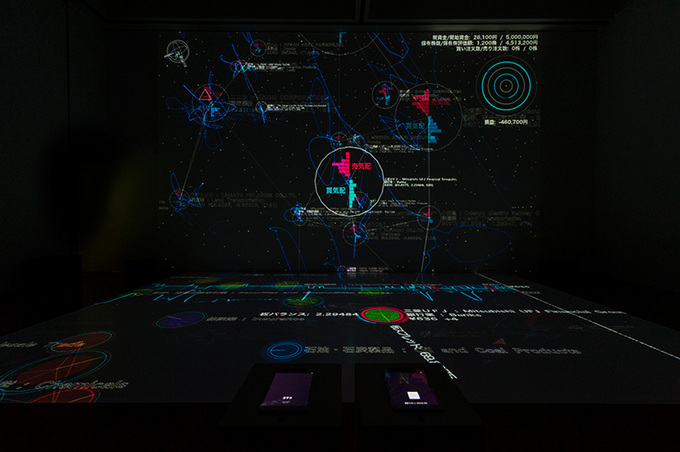
traders (realtime visualization of Tokyo Stock Exchange), 2014
Installation view at Museum of Contemporary Art Tokyo
Photo: Eiji Ina
What are the things you are trying to convey to the audience?
Ishibashi: It begins with there being a good match between what I want to express, and what technique I want to try to make a piece with. For example, in the work shadow where I attached a spotlight onto a drone, I came up with the idea because I wanted to know whether it was possible to create something beautiful and functional by putting a spotlight on a drone. And so this time, the technical challenge involved in realizing this visually came from creating a remote-controlled spotlight small enough to be attached to the drone. However, you can't call this by itself an artistic expression. MIKIKO, who is a choreographer, worked with me on how the drone would move, and how the performance would unfold.
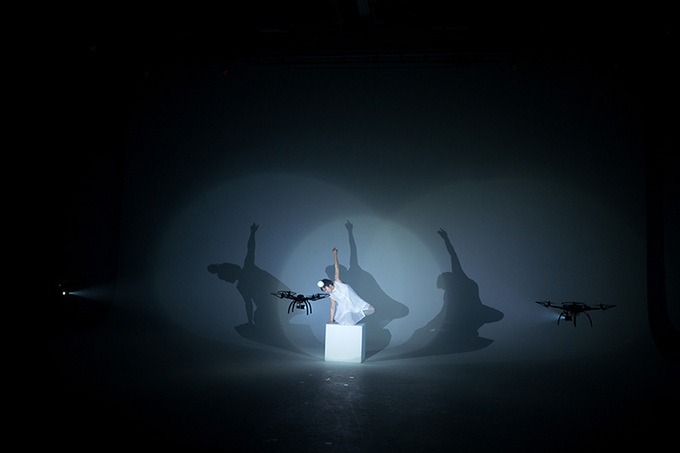
Rhizomatiks Research x ELEVENPLAY "shadow", 2015
Photo: Muryo Homma (Rhizomatiks Research)
Do you actively engage in such large scale experiments to get your ideas?
Ishibashi: About once every six months, we bring ourselves to a large studio that's far away from Tokyo, and have a "production boot camp" together when we have to work on several major projects at once. There are 10 people on our hardware team, with different areas of expertise, like crafts for technical costumes which requires fine and meticulous manual work as well as technique, and manufacturing of networks and systems for devices, electric circuits, printed-circuit boards, and so on. We all share what we want to do as a team, and each one of them do the best that they can do, instead of me always giving them instructions.
How do you divide and conquer the hardware and software, they are such different medias?
Ishibashi: As for the order of operations, we develop hardware first. After hardware is done, we elaborate on software. Which means, if there is no hardware yet, we delay the tasks of software team. As for the hardware design, I think something that "makes sense" is beautiful. Hardware production is much more demanding than software production because it has a lot of restrictions in the capability of what can and cannot be done. I think prioritizing what "makes sense" rather than decorative aspects bring out essential beauty.
Manabe: We often have to deal with production in a short amount of time, which is characteristic of our projects. So for software, we make some basic tests to find out what the restrictions are, think about how to manipulate the software within these restrictions, and then run a simulation before the completion of hardware. I think this is our team's strength. Although it is quite hard to break new ground every time, because each project requires us to confront some new challenges, from video, to drones to 3D formats. The same goes for hardware.
How does your personal background influence your career as an artist?
Ishibashi: The most influential element of what initially peaked my interest in media art was Ryuichi Sakamoto (1952-). From high school through my college years, I religiously went to Mr. Sakamoto's concerts and live performances. Back then he had been staging his performances with digital elements along with people like Daizaburo Harada (1956-), Toshio Iwai (1962-), and Koichiro Eto (1971-). If I go back even further to when I was in high school, I had a dream of creating an amusement park. I was more interested in creating roller coasters and mechanical things, rather than creating or planning out the architecture of the park, so I went to an engineering school and studied control and system engineering. I started making my own work when I moved on to IAMAS (Institute of Advanced Media Arts and Sciences) after graduating from college. I found out that it was an interesting school where people like Toshio Iwai were involved, so I chose IAMAS in Gifu instead of going on to graduate school. The president of IAMAS was Itsuo Sakane, an expert of the history of media art, and the school was a really free-spirited. The first half of the day we'd take classes, and the second half, we could focus on making our own work. My first exhibition was at the ICC (NTT InterCommunication Center), a media art center, of a game I had made by attaching a screen that can be controlled by acceleration sensors and angle sensors. The good thing about IAMAS was that the student body was half and half between former art students who weren't familiar with the computer, and students who could engineer, but had never made art, like me. It was a natural process to be asked to provide the engineering skills required for some kind of creative work, and so the foundation for cooperation was slowly built. The media artist Ryota Kuwakubo (1971-) was a peer of mine, and I have helped him out with his work too.
When did you first meet each other?
Ishibashi: After graduating IAMAS, I worked at the Tokyo University of the Arts as a part-time instructor. That is where I first met Daito when he came from IAMAS as my replacement. The very first work we collaborated on together was an interactive video work installed at the entrance of a department store, a screen that showed someone what they looked like seven seconds ago (the work is based on the idea from cognitive science that what humans recognize as "the present moment" includes seven seconds before and after that moment). That was in 2004.
After that, we continued our collaboration and exhibited a controllable LED light using RFID (Radio-frequency identification) at a demonstration fair for an LED company.
Manabe: Back then Ishibashi was kind of a pioneer artist undertaking various commission works using methods from technology art. When I first got involved in commission works after being invited by him, I was shocked that the kind of work I had been making individually had actually become a kind of job. Like, "Oh, we can make money by doing this?!" We started Rhizomatiks as a web design and creation company in the beginning. Then it was in 2006, three years after the launch of the company, that we started to receive offers for interactive projects as commission work.
You've mentioned that Étienne-Jules Marey resonates with you, for his attitude towards creativity. Why?
Manabe: Marey's approach was innovative because he interpreted dancing as visual image and as data. Just around the same time, the origin of what we've been doing was born and important researchers and artists started to emerge. Their influence is huge, I guess, and we stand on an extension of the education they have established. We consider their works as research, rather than art. As for French artists, I like contemporary composers like Pierre Boulez and Iannis Xenakis. Xenakis was especially unprecedented, using algebra instead of stochastic logic in music composition with novel applications of set and group theory, pulling off something that was very advanced that cannot be even achieved by computers at the time. He is such an admirable artist.
For artists, what do you think technique means?
Manabe: I think there are two types of technology artists. One type possesses a "craftsmanship", with excellent skills for engaging in creation. Another one is a person who thinks of a concept, but not engaged in the actual production. Both Ishibashi and I have passion for "craftsmanship", otherwise we feel that our work would not be good enough. The process is not yet generalized at all, and we find that the worth is in attempting the challenges by ourselves. I am satisfied in being treated not as an artist, but as a craftsman. In the field of art, often a concept is more valued than the skill of a craftsman. But I think Japan has a stronger tendency to emphasize those who are "hands-on" as more important, compared to some other countries.
Ishibashi: Now that we have more staffs, we can develop our projects without engaging ourselves in craft directly, but I also feel like that's just not good enough. Before, when I first started to create my work, I had to be more hands-on, otherwise nothing would get done. Now I don't have to do that, but I want to stay involved in the process myself.
Are the innovation of technology and expression involved in your creative activities for yourself? Or are they to further innovate leading technologies and expression in the global context?
Manabe: Sometimes there are artists that try to change the world only by raising questions. I think that overestimates art, and is a bit pompous. I think that media art can go even further, and answer that question. What I want to do is not claim that art has the power to change the world, and then just leave the problem alone after raising the question. For example, instead of just raising the question of the danger of drones and exhibiting such documentation, it's possible to demonstrate with a prototype. I'm not interested in some roguish style of assuming influence and trendiness but then staying far away from solving anything.
Ishibashi: I don't think about the audience's reaction at all when creating the art work. But on the other hand, I almost exclusively think about the audience when staging for a concert or with work relating to entertainment.
Manabe: With entertainment work, I think that what the audience sees is the most important, but with art work, what the artist saw is the most important.
Ishibashi: In my case, for art I think about what is interesting technically, and with entertainment, I don't focus on whether the technology at hand is interesting or not, but rather on what kind of staging effects it will have, and how the fans will enjoy it. With media art work, I am conscious of the fact that the technical aspect is also being observed.
Daito Manabe, In the collaborative work Sensing Streams - invisible, inaudible (2015) with Ryuichi Sakamoto, following an order by Yukiko Shikata, you attempted to collect and visualize electromagnetic waves in various ranges of frequency emitted from electronic devices like mobile phones.
Manabe: We got the inspiration for Sensing Streams when we started to deal with art works using wireless technology such as drones, and we found out that a great amount of electric waves were flying around us. These wireless waves nowadays have become an important infrastructure not only on stage but also in our daily lives, and people rely heavily on them, unconsciously. The concept of "seeing something invisible" is derived from our desire to see the environment we actually live in.
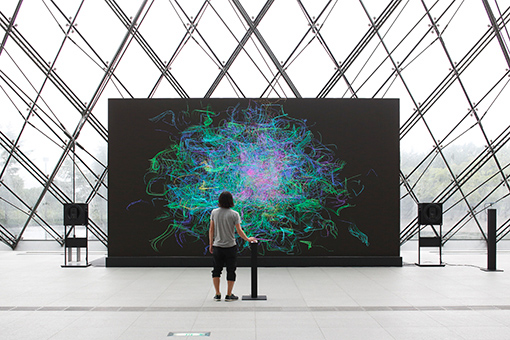
Ryuichi Sakamoto + Daito Manabe Sensing Streams - invisible, inaudible, 2014
Installation view at Sapporo International Art Festival 2014
Photo: Keizo Kioku
Photo courtesy of Creative City Sapporo International Art Festival Executive Committee
The theme for rate is the same. LED light sources, which we are familiar with, are actually flashing so fast when we use it, but cannot be recognized with the naked eye. The same goes for LCD screen and lasers, in other words, what we see and what is actually happening there are different. People two thousand years ago used to see things only as it is seen by the naked eye. But it's not the same with today. Lately filament lamps are being substituted by LED lights. Even though they both just seem like the same kind of light to our eyes, there might be some influence that we do not currently recognize. In this way, we have been making work that reflects this realization that what humans perceive and what is actually happening can be very different. We are experimenting with how we can create similar realizations with sound as we do with vision. Dogs and cats are able to hear a wider range of frequencies than humans, and it's rather curious as to why human beings discarded this ability over the course of evolution.
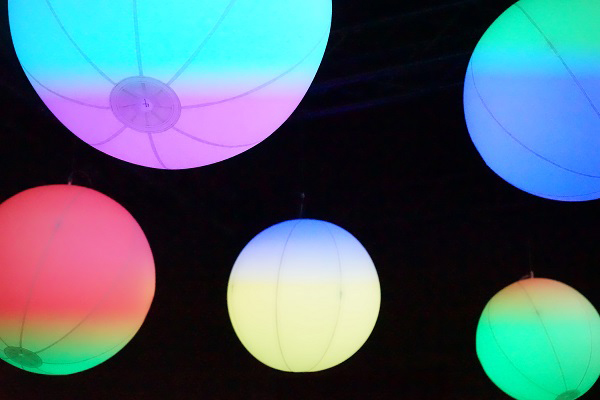
Manabe Daito + Motoi Ishibashi rate, 2012
Photo: Daito Manabe
Interview and Editorial assistance: Akiko Saito (Rhizomatiks)
(The interview originally appeared in the exhibition catalogue of Transphère #1.)
The MCJP hosts Magical House, an exhibition of the Japanese architecture unit Atelier Bow-Wow and the French-based architect Didier Fiuza Faustino, as the second exhibition of Transphère series from June 8, 2016. This exhibition is curated by Hon Hanru, Artistic Director of the National Museum of 21st Century Arts in Rome.
In January 2017, as the third exhibition of the series, Rei Naito's work, which is a space for prayer she created for her hometown Hiroshima for the first time, will be reproduced.
The MCJP is to organize nine exhibitions for the series, three exhibitions per year, starting from FY 2016 for three years. The series plans to show never-before-seen works by artists from Japan and abroad and to create chances for them to collaborate with each other beyond nationality. Audience can enjoy ambience and atmosphere that radically change at each exhibition depending on the artist or creator.
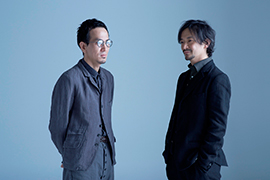
Left: Motoi Ishibashi
Right: Daito Manabe
Photo: Shizuo Takahashi
Daito Manabe
Artist / Programmer / DJ
Daito Manabe was born in 1976 and lives and works in Tokyo. In 2006, he launched Rhizomatiks, a company specializing in web, interactive, and graphic design as well as architecture. Since 2015, he has been working with Motoi Ishibashi on Rhizomatiks Research, spearheading research and development projects. In collaboration with artists from various disciplines, he also works on projects that privilege interactive design.
In 2011, particles, which he created in collaboration with Ishibashi, received an Award of Distinction in the interactive art category of the Prix Ars Electronica. Since 2011, he has collaborated with the dance company ELEVENPLAY. He makes use of various technologies, such as computer vision, drones, and robotic arms, to give birth to new forms of physical expression.
http://daito.ws/
Motoi Ishibashi
Artist / Engineer
Motoi Ishibashi was born in 1975 in Shizuoka and he lives and works in Tokyo. After studying control systems engineering at the Tokyo Institute of Technology, he went on studying mechanical and image processing engineering at the Institute of Advanced Media Arts and Sciences (IAMAS) in Gifu, at the inception of digital media production. He is currently working on the development of new artistic methods touching on both the visual environment and the elaboration of engineering solutions in terms of artistic production and interactive public spaces. In 2011, he and Manabe were the recipients of an Award of Distinction in the interactive art category of the Prix Ars Electronica. That same year, he received the Excellence Award at the 15th edition of the Japan Media Art Festival. Since 2015, he has co-directed Rhizomatiks Research, an organization devoted to research and development in the spheres of art, technology, and entertainment, along with Manabe.
Back Issues
- 2023.12. 7 Movie Theaters aroun…
- 2023.6.16 The 49th Japan Found…
- 2023.4.24 The 49th Japan Found…
- 2022.12.27 Living Together with…
- 2022.12.27 Living Together with…
- 2022.8.12 Inner Diversity <…
- 2022.3.31 The 48th Japan Found…
- 2022.3.29 Beyond Disasters - T…
- 2021.11.29 Crossing Borders, En…
- 2021.4.13 Crossing Borders, En…


